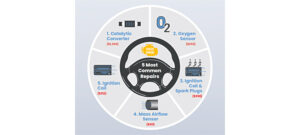Significant shifts in product distribution over the last five years concentrates more volume among three channels
Fort Wayne, Ind.—Do-It-For-Me (DIFM) product volume averaged over 78% of the car and light truck aftermarket between 2018 and 2023 as it expanded nearly $10 billion at user-price. Five distribution channels supply the car and light truck aftermarket, and each has achieved different growth results in the rapidly expanding DIFM market, according the latest Lang Aftermarket iReport.
However, there were significant shifts in DIFM product distribution over those five years, as volume became more concentrated among three channels. Here are key takeaways from the analysis.
Aftermarket Channel Distribution
Five distribution channels supply the car and light truck U.S. aftermarket: Traditional, Integrated, Specialized, Import, and the OE channel. DIFM products averaged a different share of each channel’s volume mix between 2018 and 2023.
DIFM Share of Channel Sales Mix
From 2018 to 2023, the OE channel had the largest share of its volume generated by DIFM products, approximately 95%, followed by the Import channel, which had 93% of its sales in the DIFM sector.
The Specialized channel ranked third in DIFM’s share of its sales, 90%, followed by the Traditional channel, for which DIFM products averaged over 85% of its volume.
The Integrated channel, largest of the five channels, stood apart from the others in its sales mix, with the DIFM market at only about 60% of its volume.
Channel Share of DIFM Product Growth
While Lang noted that the DIFM market climbed about $10 billion in product sales at user-price between 2018 and 2023, the five channels differed significantly in their DIFM performances; consequently, DIFM volume became more concentrated among a few channels.
Integrated Channel Grows
In the Integrated Channel, products do not change ownership or franchised affiliation from the time of purchase from manufacturers to sale to end-users or installers. Despite DIFM sales representing only about 60% of its volume, the Integrated channel achieved the second-fastest rate of yearly DIFM growth, over 3%.
Traditional Channel Underperforms
The Traditional channel consists of traditional warehouses and traditional jobbers engaged in two- and three-step distribution. Despite ranking second in DIFM product share between 2018 and 2023, the Traditional channel recorded less than 1% DIFM annual growth.
Import Channel Gets Boost
The Import Channel is home to import warehouses and import jobbers. The smallest of the five major channels, the Import Channel, nevertheless recorded the highest annual DIFM product growth rate between 2018 and 2023, nearly 4%.
Specialized Channel Retreats
The Specialized Channel is focused on a limited range of products or a specific segment of the aftermarket. It averaged over $13 billion in DIFM product volume between 2018 and 2023 but declined in DIFM sales.
OE Channel Expands
The OE channel is composed of carmakers and their suppliers, who ship automotive products to dealers. The OE channel recorded the third-highest rate of DIFM annual growth, almost 3%, topping by over half the expansion pace of the total DIFM market.
Channel Share of DIFM Product Growth
The Integrated channel generated about 48% of the nearly $10 billion surge in DIFM volume at user-price between 2018 and 2023, followed by the OE channel with an approximately 30% growth share. The Import Channel generated over 15% of DIFM product growth, states Lang.
In contrast, the Traditional channel managed to create only about 6% of DIFM product growth, and the Specialized channel suffered a decline in DIFM volume.
Shifting Distribution of DIFM Products
Lang notes three trends that are reshaping the distribution of DIFM aftermarket products in the U.S.
• DIFM volume is becoming more concentrated among a few channels, with the Integrated and OE channels expanding their DIFM market positions by the greatest margins, followed by the Import channel with a substantial DIFM sales gain.
• The Integrated channel, with the smallest DIFM share of volume mix, generated about 48% of DIFM market growth. Already a dominant force in the Do-It-Yourself (DIY) market, the Integrated channel is also seizing a leading position in the DIFM market.
• The OE channel has gained strength in the DIFM market over the past five years, expanding its DIFM growth share to approximately 30%. Accordingly, the OE channel has reduced the combined DIFM market share of the four Independent (non-Dealer) channels.
Aftermarket Consequences
The significant changes in the flow of DIFM products through the five major distribution channels illustrate fundamental changes in the sales and distribution dynamics of the light vehicle DIFM market, Lang states.
• The concentration of DIFM volume in three distribution channels will increase brand competition in the DIFM market as more product volume is forced through fewer channels.
• The expanding position of the Integrated channel in the DIFM market underscores the success of retail auto parts chains selling in the commercial (DIFM) market and the growth of eCommerce in the DIFM market.
• The expanding DIFM share of the OE channel shows that the four Independent channels must renew their efforts to reach two of the fastest-growing sectors of the DIFM market: foreign nameplates and high-tech repair.








Comments are closed.